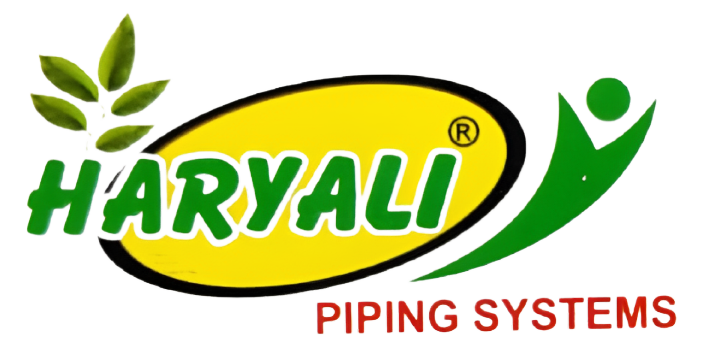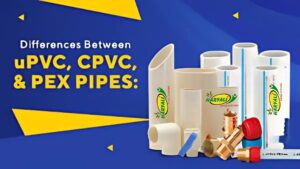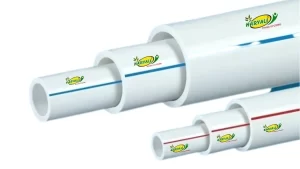As a leading manufacturer & supplier in the industry, Polyshakti Pipe is here to help you understand the difference between these two types of pipes and how to choose the right one for your project. PVC is one of the most widely produced and used synthetic polymers. Plasticizers are added during the manufacturing of PVC in order to make it easy to bend and to increase its flexibility. While both CPVC and uPVC are plastic pipes commonly used in plumbing, they have distinct characteristics that make them better suited for specific applications.
When it comes to plumbing pipes, choosing the wrong one can lead to costly repairs down the line. However, by understanding the differences between CPVC and uPVC pipes, you can feel more confident in your plumbing decisions. Both materials have distinct characteristics, advantages, and applications that make them suitable for different plumbing needs.
What is UPVC?
UPVC, standing for Unplasticized Polyvinyl Chloride, is a widely used plastic pipe material known for its affordability, durability, and versatility. It is a rigid PVC, devoid of any plasticiser. Known for its resilience, UPVC is a robust, transparent, and durable material with excellent resistance to atmospheric influences, moisture, and various chemicals. UPVC pipes are most commonly used for cold water applications in plumbing, water supply, underground drainage, and sewage lines.
Features of UPVC Pipes
Lightweight: UPVC pipes are extremely lightweight compared to metal, concrete and other plastic pipes, making them easier to handle, transport, and install.
UV-resistant: These pipes prevent damage against harmful UV rays making them suitable for outdoor usage as well.
Durability: UPVC pipes are resistant to corrosion, rust, and chemical reactions, making them ideal for use in a wide range of environments, including areas with exposure to harsh chemicals or water.
Non-Toxic: These pipes are chemically inert meaning that they do not react to chemicals making them ideal for the transfer of chemical effluent in industries. UPVC pipes do not release harmful chemicals, making them safe for use in drinking water systems and other environments where hygiene is important.
Applications of UPVC Pipes:
The UPVC (Unplasticised Polyvinyl Chloride) pipes and fittings are the ultimate solution for cold water applications across sectors like residential plumbing, swimming pools, food and beverage industries, saltwater lines, and chemical processes. UPVC pipes are commonly used for wastewater transportation, including for residential and industrial sewage systems. UPVC pipes can be used in fire fighting systems, especially for dry riser or sprinkler systems, where the pipes are not exposed to extreme temperatures or fire directly.
What is CPVC?
CPVC, which stands for Chlorinated Polyvinyl Chloride, is a type of plastic pipe specifically designed for plumbing applications. It is created by taking the regular PVC (polyvinyl chloride) and adding chlorine to its molecular structure. CPVC pipes are more flexible than UPVC or PVC pipes. These pipes are made of thermoplastics making them suitable for both hot and cold supply of fluids.
It is ideal for hot and cold-water applications in individual homes, residential apartments, commercial buildings, hotels, and hospitals.
Features of CPVC Pipes
Heat Resistance: CPVC pipes can withstand higher temperatures than regular PVC pipes, typically up to 200°F (93°C), making them suitable for hot water applications such as plumbing systems, industrial processes, and heating systems.
Flexible and strong: CPVC pipes are really strong just like any other variant of the PVC pipe family. However, these pipes are surprisingly much more flexible than the other variants.
Durability: Like UPVC, CPVC pipes are resistant to corrosion, rust, and chemical degradation. They are highly durable and can last for several decades, even under harsh conditions. CPVC pipes prevent damage against harmful UV rays and are suitable for outdoor usage as well.
Flexibility in Application: CPVC pipes are really strong just like any other variant of the PVC pipe family. CPVC pipes are used in a variety of applications, including potable water systems, hot water supply lines, fire sprinkler systems, and industrial processes, due to their resistance to heat and chemicals.
Applications of CPVC Pipes:
CPVC PIPES are flexible and strong, this pipe is suitable for both hot and cold conditions. These pipes are widely used in residential projects like homes, apartments, hotels, and high-rise buildings, ensuring clean and hygienic water flow. Moreover, the CPVC pipes are suited for use in water mains in both domestic and industrial settings as well as plant piping because of their excellent chemical properties. CPVC pipes are commonly used in fire sprinkler systems because they are resistant to high temperatures and flame retardant.
Conclusion:
PVC, a widely utilised material in pipeline production, comes in two distinct types: UPVC and CPVC. The critical difference lies in their composition, UPVC is made without plasticisers, while CPVC involves the addition of plasticisers and a chlorination process. If you require a more robust, temperature-resistant piping system capable of handling hot water and high-pressure situations, CPVC pipes are the way to go. Always consult with a professional plumber or engineer to assess your needs accurately and make an informed decision that ensures the long-term efficiency and safety of your plumbing system. The choice between UPVC and CPVC largely depends on the temperature and chemical exposure in the system, with CPVC being the preferred option for high-temperature applications. If you are looking to buy UPVC OR CPVC pipes, pls give a chance to PolyShakti Pipes, who is known as the best UPVC & CPVC pipes manufacturer.
Overall, both UPVC and CPVC pipes are versatile, reliable, and cost-effective solutions that play a crucial role in modern plumbing, industrial systems, and infrastructure.


